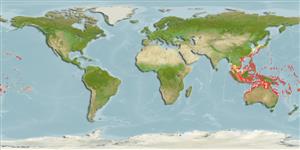Teleostei (teleosts) >
Eupercaria/misc (Various families in series Eupercaria) >
Labridae (Wrasses) > Corinae
Etymology: Coris: Greek, kore, -es = pupil and also with themenaing of "maid" (Ref. 45335).
Eponymy: Joseph (or Jean, according to some sources) Paul Gaimard (1796–1858) was a French naval surgeon, explorer and naturalist. [...] (Ref. 128868), visit book page.
More on authors: Quoy & Gaimard.
Environment: milieu / climate zone / depth range / distribution range
Ecology
Marine; reef-associated; depth range 0 - 50 m (Ref. 1602). Tropical; 37°N - 31°S, 96°E - 142°W
Pacific Ocean: Christmas and Cocos-Keeling Islands in the eastern Indian Ocean to the Society and Tuamoto islands, north to Japan and the Hawaiian Islands, south to Australia. Replaced by Coris cuvieri in the Indian Ocean (Ref. 37816).
Size / Weight / Age
Maturity: Lm ? range ? - ? cm
Max length : 40.0 cm TL male/unsexed; (Ref. 2334); common length : 20.0 cm TL male/unsexed; (Ref. 27550)
A solitary species (Ref. 90102) found in areas of mixed coral, sand and rubble of exposed outer reef flats, lagoon and seaward reefs (Ref. 1602, 48636). Benthopelagic (Ref. 58302). Feeds mainly on mollusks, crabs, and hermit crabs, and occasionally on tunicates and forams (Ref. 1602). Minimum depth reported taken from Ref. 128797.
Life cycle and mating behavior
Maturity | Reproduction | Spawning | Eggs | Fecundity | Larvae
Oviparous, with distinct pairing during breeding (Ref. 205).
Randall, J.E., 1999. Revision of the Indo-Pacific labrid fishes of the genus Coris, with descriptions of five new species. Indo-Pac. Fish. (29):74 p. (Ref. 33411)
IUCN Red List Status (Ref. 130435: Version 2024-2)
Threat to humans
Reports of ciguatera poisoning (Ref. 4690)
Human uses
Fisheries: commercial; aquarium: public aquariums
Tools
Special reports
Download XML
Internet sources
Estimates based on models
Preferred temperature (Ref.
123201): 24.3 - 29, mean 27.9 °C (based on 690 cells).
Phylogenetic diversity index (Ref.
82804): PD
50 = 0.5000 [Uniqueness, from 0.5 = low to 2.0 = high].
Bayesian length-weight: a=0.00977 (0.00466 - 0.02049), b=3.07 (2.90 - 3.24), in cm total length, based on LWR estimates for this (Sub)family-body shape (Ref.
93245).
Trophic level (Ref.
69278): 3.5 ±0.2 se; based on diet studies.
Resilience (Ref.
120179): Medium, minimum population doubling time 1.4 - 4.4 years (Preliminary K or Fecundity.).
Fishing Vulnerability (Ref.
59153): Low to moderate vulnerability (30 of 100).
Nutrients (Ref.
124155): Calcium = 35.7 [14.0, 96.2] mg/100g; Iron = 0.552 [0.329, 0.970] mg/100g; Protein = 18.6 [15.7, 20.8] %; Omega3 = 0.128 [0.065, 0.250] g/100g; Selenium = 34 [13, 94] μg/100g; VitaminA = 98.9 [32.3, 339.5] μg/100g; Zinc = 1.85 [0.86, 3.31] mg/100g (wet weight);
